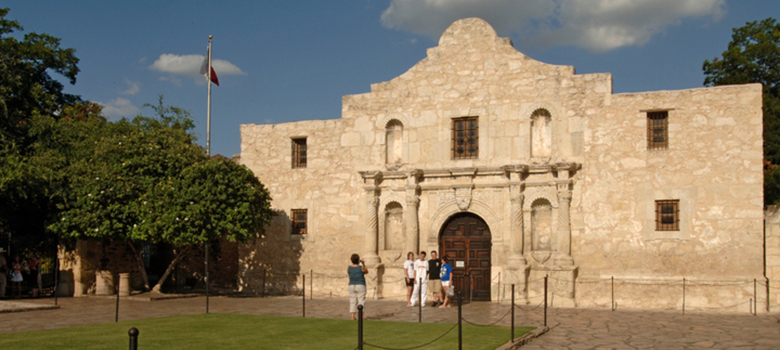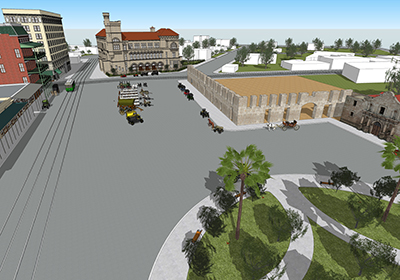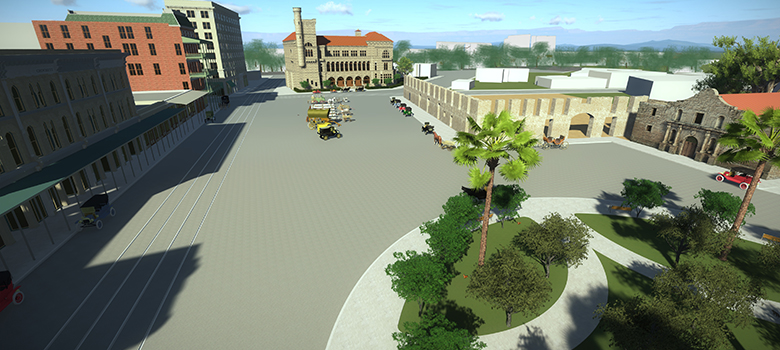
(Feb. 22, 2018) -- The Alamo is one of the most recognizable structures in the world, and one of the most hallowed sites in Texas history. A professor at The University of Texas at San Antonio (UTSA) is working to recreate its history with a series of interactive visual models going back from its beginnings to present day.
Richard Tangum, professor of Urban and Regional Planning with the UTSA College of Architecture, Construction and Planning (CACP), and teams of UTSA undergraduate and graduate students are using 3-D architecture modeling software to create explorable and interactive environments that provide an accurate and in-depth view of what Alamo Plaza was like at key points during its 300-year history.
“The intent of our ongoing project is to show how the Alamo has had many different uses over time, and how its transformation has shaped and been shaped by the city’s own changes over time,” Tangum said. “The Alamo has functioned as a Roman Catholic mission, fortress compound and garrison, the site of one of the most famous battles in Texas history, a commercial area and an entertainment setting. Its history is long and vast, and we want to help share it in an interactive way.”

In a circa 1912 model created by UTSA, users can explore a painstaking re-creation of Alamo Plaza that includes the buildings around the Alamo designed and modeled to their historical specifications. Virtual depictions of San Antonio citizens stroll the plaza surrounded by Ford Model T cars, horses and carriages, and figures depicting the famous Chili Queens of San Antonio.
In another model, users can interact with a depiction of the siege and battle of the Alamo in 1836. Mexican soldiers surround the Alamo as Texans, including historic figures like James Bowie, William B. Travis and Davy Crockett, stand to defend it.
Tangum and his team are taking great care to ensure that their models are as authentic as possible. Their project has involved seeking out old maps, building schematics, newspaper clippings and documents from the eras they are recreating. Tangum and his students have also spent countless hours in archives, searching for pictures of buildings that have long since disappeared or been completely changed to ensure the accuracy of their re-creation.
Tangum’s interest in the evolution of Alamo Plaza began more than 20 years ago when he created a special exhibit on Alamo Plaza for the Texas Society of Architects. At the time, he collected hundreds of photographs and maps to trace its growth and change for the exhibit. Today, he’s sharing that passion with his UTSA students.
“Using 3-D modeling software allows us to create an educational tool that can be built upon and used by future generations with an interest in the Alamo,” Tangum says. “The project can become more and more immersive as the technology develops and will serve as a valuable resource for learning.”

In the coming months, Tangum hopes to add more time periods to the project and create as lifelike a representation as possible. He and his students have also been exploring more advanced software to integrate interactive avatar models that would allow users to interact with and engage in dialogue with digital models of people who lived during that time.
“As we look at San Antonio’s last 300 years, we need to understand how our city’s iconic places have changed and transformed alongside the rest of the city,” Tangum says. “As we prepare for the next 300 years, we need to understand the past. This is my small way of helping with that.”
UTSA is ranked among the top four universities in the nation under 50 years old, according to Times Higher Education.
Learn more about the UTSA Center for Urban and Regional Planning Research and the UTSA College of Architecture, Construction and Planning.
View a demonstration of the project, Evolution of Sacred and Urban Space.
Connect with UTSA online at Facebook, Twitter, YouTube, Instagram and LinkedIn.
UTSA Today is produced by University Communications and Marketing, the official news source of The University of Texas at San Antonio. Send your feedback to news@utsa.edu. Keep up-to-date on UTSA news by visiting UTSA Today. Connect with UTSA online at Facebook, Twitter, Youtube and Instagram.
Move-in Day is an exciting time for incoming students. Students living in Chaparral Village move in from August 20-21. The UTSA Housing and Residence Life (HRL) team looks forward to welcoming you all and helping you settle into your room.
Chaparral VillageMove-in Day is an exciting time for incoming students. Students living in Laurel Village move in on August 22. The UTSA Housing and Residence Life (HRL) team looks forward to welcoming you all and helping you settle into your room.
Laurel VillageThe College of Sciences welcomes our newest Roadrunners to UTSA at VIVA Science! This interactive event connects students with faculty, staff, student leaders, and peers while highlighting the opportunities available across the College.
Outdoor Learning Environment 2 (OLE), Flawn Building, Main CampusWe're excited to welcome the new class of UTSA College of Liberal and Fine Arts (COLFA) students to campus! Move In To COLFA is strongly recommended for new students in COLFA because it gives you the chance to learn about the Student Success Center, learn how to do college successfully and meet new friends.
Galleria (MH 2.01), McKinney Humanities Building, Main CampusBuild connections with your Alvarez College of Business peers and learn more about the Career Compass program! This opportunity will provide fun interactions, giveaways and a chance to meet your next friend!
Richard Liu Auditorium (BB 2.01.02,) Business Building, Main CampusCelebrate the end of summer and the start off a great fall semester with The Housing Block Party! This event will have live music, carnival-style treats, artists, games, and activities galore. Come and join us for a night of fun!
Multipurpose Room/Lawn, Guadalupe Hall, Main CampusBe part of an unforgettable night as SOSA takes the field for its first public performance of the season! Experience the power, pride, and pageantry of UTSA’s marching band. Learn beloved traditions, practice cheers, and feel what it means to be a Roadrunner.
Campus Rec FieldsThe University of Texas at San Antonio is dedicated to the advancement of knowledge through research and discovery, teaching and learning, community engagement and public service. As an institution of access and excellence, UTSA embraces multicultural traditions and serves as a center for intellectual and creative resources as well as a catalyst for socioeconomic development and the commercialization of intellectual property - for Texas, the nation and the world.
To be a premier public research university, providing access to educational excellence and preparing citizen leaders for the global environment.
We encourage an environment of dialogue and discovery, where integrity, excellence, respect, collaboration and innovation are fostered.